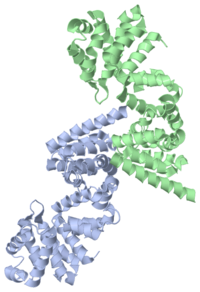C-terminal portion of human eIF4GI (1ug3)
The X-ray structure of the C-terminal region of human eukaryotic translation initiation factor 4G (eIF4G) has been determined at 2.2 A resolution, revealing two atypical HEAT-repeat domains. eIF4G recruits various translation factors and the 40S ribosomal subunit to the mRNA 5' end. In higher eukaryotes, the C terminus of eIF4G (4G/C) supports translational regulation by recruiting eIF4A, an RNA helicase, and Mnk1, the kinase responsible for phosphorylating eIF4E. Structure-guided surface mutagenesis and protein-protein interaction assays were used to identify binding sites for eIF4A and Mnk1 within the HEAT-repeats of 4G/C. p97/DAP5, a translational modulator homologous to eIF4G, lacks an eIF4A binding site in the corresponding region. The second atypical HEAT domain of the 4G/C binds Mnk1 using two conserved aromatic/acidic-box (AA-box) motifs. Within the first AA-box, the aromatic residues contribute to the hydrophobic core of the domain, while the acidic residues form a negatively charged surface feature suitable for electrostatic interactions with basic residues in Mnk1.
Protease cleavage sites (especially caspase cleavage sites) are frequently situated in flexible, unstructured regions of proteins. In eIF4GI, eIF2Bε, and eIF5, where the caspase cleavage site is absent, is structured and characterized by an α3-α4 interunit loop. The superposition of α3 and α4 of eIF4GI (1ug3, blue) to α3 (orange) and α4 (lime) of C-terminal domain of human DAP5/p97 (DAP5-CTD, 3d3m) is shown.
There are only 3 pairs of between α3 and α4 of DAP5-CTD. In contrast, there are more interactions at the stabilizing the interaction between α3 and α4 in eIF4GI.

